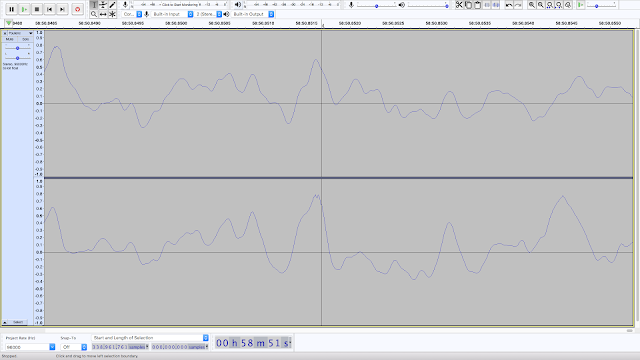 |
| Using DVD-5000 to decode HDCD on played on PD-75 as digital transport |
I've been testing a pair of the DVD-5000's I originally bought for use as living room DACs. They are both for sale on ebay as I write this. I am reminded of the fact they are very good, and according to objectivist standards should not be audibly different from the very best DACs. They also have the ultimate R2R chip made by Burr Brown, the PCM 1704, which was discontinued in 2012. By objectivist standards, it should be no different than a good Sigma Delta chip. But it is different in objective ways, for what that's worth. I love the DVD-9000 for HDCD decoding but don't use it for anything else. I would have been tempted to use DVD-9000 for midrange DAC until I discovered that I needed 3 DACs of exactly the same design for my tri-amplified system. Even if I adjusted the delay times for one particular sampling rate, when I changed sampling rates those adjustments would no longer be valid, because the latency of nearly every device varies with sampling rate.
Faced with that problem, and the (at the time) skyrocketing price of DVD-9000's, I opted to get 3 DVD-5000's instead. Those would be basically the same thing, I predicted.
But for probably no good reason, I just never fell in love with the DVD-5000's the way I did for the DVD-9000. And it was much more convenient to have multiple DACs with level controls, and smaller. So I ended up with 3 Emotiva Stealth DC-1's, which are quite fine also (technically they measure much better than the DVD-5000's, but once again that difference should not be audible).
I still use DVD-9000 for decoding HDCD's (because my Oppo BDP-205 doesn't do that). So I tried using the DVD-5000 (which doesn't actually play discs, but connected as a DAC to the digital output of a Pioneer PD-75, optically) and I found it does indeed do very well with HDCD's, just like my DVD-9000.
But it is different. When playing an HDCD the output level never exceeds the output level from an ordinary CD. The DVD-9000 actually plays the level expanded portions of an HDCD up to 6dB louder than an ordinary CD. In contrast, the DVD-5000 does what every other HDCD player I've ever tested (other than the DVD-9000), it lowers the average level, just so so the most expanded peaks of HDCD reach the maximum CD level, but no more than that.
When my brother-in-law George first heard the HDCD on a DVD-9000, he was (unusually I'd say, because he never matches levels by measuring) shocked and appalled that that HDCD boosted levels 6dB above normal CD levels. He felt that was unfair. HDCD was all just a cheat, he insisted.
Well, as I've started to explain in many other previous essays, it's much more complicated than George and almost everyone thinks, because of inter sample overs.
(And of course, George was also wrong that HDCD players boost the level beyond that of CD's. Though for the longest time I wondered if earlier HDCD players did do that boosting, and it changed when players stopped using the PMI chips. I had it reversed. The DVD-5000 uses PMI chips and doesn't do boosting beyond CD levels. The DVD-9000 uses a software implementation--like all later players--and does boos the level. So it does not necessarily have anything to do with using the chip, it was just a particular approach the designers of the DVD-9000 took, which possibly was available to the users of the chip as well, but I haven't seen one that does.)
The ISO's on regular digital recordings can match those of even peak level expanded HDCDs. And what's more, HDCD's don't seem to have such as big ISOs. So it comes out about as a wash, the HDCD is just giving a kind of engineered peak, and regular CD's are giving us extrapolated peaks. That dynamic range in the analog output was there and needed anyway, HDCD's (when boosted) are just using that dynamic range for real music dynamics, rather than extrapolations from what may be just high frequency ringing.
Now I also know, that SACDs may in fact be the worst offender of all. They can have the highest peak output above the nominal 2V level.
But I'm wondering if it was the boosted HDCD level (compared to other players) that led me to fall in love with the DVD-9000 in the first place.
(I think HDCD done as intended (and with the filter control*) would have been a great idea...as an open standard, and would have enabled a way to bypass the loudness wars, using the HDCD encoding to provide the uncompressed version which for which the compressed version would be heard without it. Now we're simply stuck with HDCD as necessary for reproduction of a significant number of fabulous sounding recordings, which are better heard when available in high resolution.)
(* The filter control somehow seems less necessary as HDCD's don't seem to have the transients that provoke excessive ISO's. Somehow they achieved that effect without a post-filter change. It will be necessary to do more investigation.)

